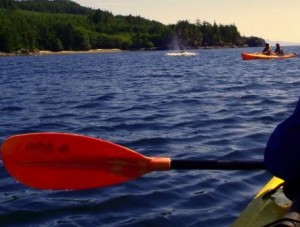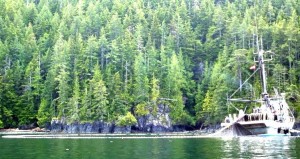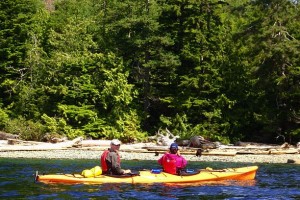
Johnstone Strait, a deep glacier carved passage running between the east coast of Vancouver Island and the west coast of British Columbia mainland, is one of the best places in the world to spot killer whales (also known as orcas). The deep waters of Johnstone Strait are home to the world’s largest resident pod of orcas, numbering around 200, who are attracted to the region by the thousands of salmon who frequent the waters every summer. Not surprisingly, there are no shortage of whale watching trips that whiz 30 plus tourists on a high speed boat, zipping around the water for a few hours before heading back to shore. You may even see whales on one of these trips, but having done one, I’ve found a more relaxing, calmer way to experience Johnstone Strait – by kayak.
I signed up for a four day/three night kayaking trip aptly named “Orca Base Camp” and offered through Coastal Spirits. The trip starts in Campbell River where our group of nine were shuttled by a high speed boat to Orca Base Camp, a tranquil spot only accessible by boat. Orca Base Camp is equipped with two person safari tents and cots so guests don’t have to sleep on the floor. All meals are prepared by the guides and there’s even a make-shift toilet. It’s not quite a five-star hotel experience, but it’s not exactly roughing it either.

Our first kayak outing resulted in no orca sightings, but we saw several bald eagles. I was disappointed, despite our guide’s warning that we might not see even a single orca on the trip. As I lay down that night I was rocked to sleep by the “phew” sound as several orcas pushed water out of their blowhole while passing our camp. They were out there, even if I couldn’t see them in the darkness.
The next day proved more fruitful. As we paddled near the shore, coming directly towards us was a pod of four orcas. We slowed our paddling, willing them to come towards us and not change direction. They must have been listening as they came straight towards us. I’m sure I could have touched them with my paddle if I had dared, which I didn’t, not wanting to disturb these majestic creatures and not wanting to break the law – it’s illegal to disturb wildlife in Canada.

The next day we headed in the same direction, close to shore, hoping to spot the orcas again. The orcas remained elusive but a black bear and her two small cubs entertained us from the shoreline as they turned up rocks looking for food. The orcas made their appearance several hours later when we were back at base camp just as the sun was setting. I heard the now familiar “phew” sound and raced down to the beach in search of them. In the distance I saw intermittent splashes of water being pushed high into the air from the orcas blowholes.
I stayed at camp for the final kayak since I wasn’t feeling well. I sat on the beach depressed that I was missing out on all the orca activity. A guide that had stayed behind tried to reassure me that the best orca sightings are often right from camp. I thought he was just being nice, but didn’t really believe him. True to his word, several minutes later an orca and her calf made their appearance several meters from shore and stayed in the area for almost thirty minutes. The rest of the group returned – with no orca sightings.
I felt a much deeper connection to the orcas and to the landscape when traveling by kayak than I had doing a high speed boat whale watching trip. I may not be able to keep up with the orcas in a kayak, but I also was not as likely to scare them off.


